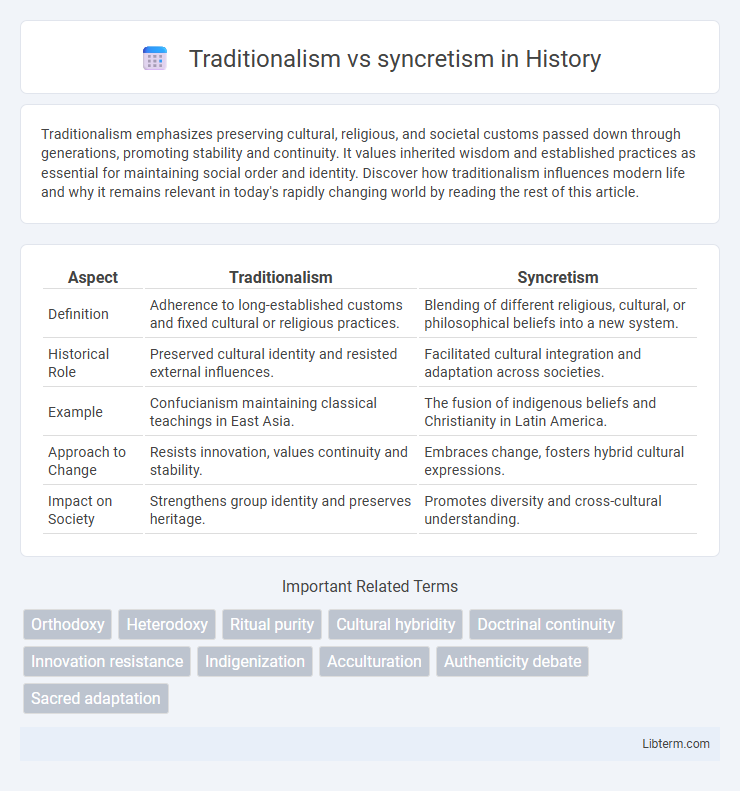Traditionalism emphasizes preserving cultural, religious, and societal customs passed down through generations, promoting stability and continuity. It values inherited wisdom and established practices as essential for maintaining social order and identity. Discover how traditionalism influences modern life and why it remains relevant in today's rapidly changing world by reading the rest of this article.
Table of Comparison
| Aspect | Traditionalism | Syncretism |
|---|---|---|
| Definition | Adherence to long-established customs and fixed cultural or religious practices. | Blending of different religious, cultural, or philosophical beliefs into a new system. |
| Historical Role | Preserved cultural identity and resisted external influences. | Facilitated cultural integration and adaptation across societies. |
| Example | Confucianism maintaining classical teachings in East Asia. | The fusion of indigenous beliefs and Christianity in Latin America. |
| Approach to Change | Resists innovation, values continuity and stability. | Embraces change, fosters hybrid cultural expressions. |
| Impact on Society | Strengthens group identity and preserves heritage. | Promotes diversity and cross-cultural understanding. |
Understanding Traditionalism: Core Principles
Traditionalism emphasizes preserving established customs, beliefs, and practices rooted in historical continuity and cultural heritage. It prioritizes authenticity, often resisting changes perceived as diluting original values or spiritual truths. The core principles revolve around reverence for ancestral wisdom, adherence to ritual purity, and maintaining social cohesion through fixed traditions.
The Essence of Syncretism in Culture
Syncretism in culture represents the dynamic blending of diverse religious, philosophical, and cultural elements to create new, hybrid belief systems that reflect evolving social realities. It contrasts with traditionalism, which emphasizes strict adherence to established customs and doctrines, preserving cultural identity through continuity. The essence of syncretism lies in its adaptability and inclusiveness, facilitating cultural exchange and transformation while maintaining core symbolic meanings.
Historical Roots of Traditionalist Thought
Traditionalist thought traces its historical roots to early religious and philosophical movements emphasizing the preservation of established customs, cultural values, and orthodox beliefs as a means of maintaining social cohesion. The rise of Traditionalism can be linked to resistance against rapid modernization and secularization in the 19th and 20th centuries, where intellectuals like Rene Guenon and Julius Evola advocated for the return to sacred knowledge and metaphysical principles. The conflict between Traditionalism and syncretism highlights the tension between conserving distinct religious identities and merging diverse spiritual elements into new, hybrid belief systems.
Syncretism Across Religions and Civilizations
Syncretism manifests across religions and civilizations by blending diverse spiritual beliefs, rituals, and practices into cohesive systems that foster cultural integration and adaptability. Examples include the fusion of Indigenous, African, and Catholic traditions in Latin American religions or the incorporation of Hellenistic and Eastern elements in early Christianity and Buddhism. This dynamic process contrasts with Traditionalism, which emphasizes preservation of original doctrines and resists doctrinal innovation or external influence.
Key Differences Between Traditionalism and Syncretism
Traditionalism emphasizes strict adherence to established customs, rituals, and beliefs rooted in historical or cultural origins, preserving original practices without alteration. Syncretism involves blending elements from different religious, cultural, or philosophical systems to create a new, hybrid belief system that adapts and evolves over time. Key differences include traditionalism's focus on continuity and purity versus syncretism's emphasis on fusion and innovation.
Case Studies: Traditionalism vs Syncretism in Practice
Case studies of traditionalism vs syncretism reveal distinct approaches to cultural preservation and adaptation; for example, in Indonesian Islam, traditionalism emphasizes strict adherence to Sharia and classical religious texts, while syncretism incorporates Hindu-Buddhist elements and local customs, creating a unique spiritual blend. Similarly, in West African Vodun, traditionalism preserves ancestral rituals and deities, whereas syncretism merges Christian symbols with indigenous practices, enhancing religious inclusivity. These cases highlight how traditionalism maintains doctrinal purity while syncretism fosters cultural hybridity, influencing identity and social cohesion.
Social and Cultural Impacts of Traditionalism
Traditionalism reinforces cultural identity by preserving rituals, languages, and customs that foster community cohesion and intergenerational continuity. It often acts as a social stabilizer, promoting shared values and norms that resist rapid modernization and external influences. However, strict adherence to traditionalism can limit social diversity and hinder cultural adaptation in increasingly globalized environments.
The Evolution of Syncretism in Modern Societies
Syncretism in modern societies has evolved as a dynamic process blending diverse cultural, religious, and philosophical systems, reflecting globalization and increased intercultural interactions. Traditionalism often resists this fusion, emphasizing preservation of established beliefs and practices while syncretism embraces innovation and hybridity. The ongoing tension shapes contemporary identity formations, religious pluralism, and cultural adaptation worldwide.
Challenges and Criticisms of Both Approaches
Traditionalism faces criticism for its resistance to change, often resulting in rigid practices that may hinder cultural evolution and adaptation to modern contexts. Syncretism, while promoting inclusivity and blending of beliefs, is challenged for potentially diluting core traditions and causing identity conflicts among adherents. Both approaches struggle with balancing respect for heritage and the need for innovation, which complicates their acceptance within diverse cultural and religious communities.
Toward Harmony: Finding Balance Between Tradition and Synthesis
Traditionalism emphasizes preserving established cultural and religious practices to maintain identity and continuity. Syncretism seeks to blend diverse beliefs and customs, fostering innovation and inclusivity within evolving societies. Finding balance between tradition and synthesis promotes social harmony by honoring heritage while embracing adaptive integration.
Traditionalism Infographic

 libterm.com
libterm.com